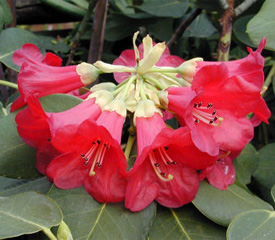Article Copied from the American Rhododendron Society Blog
Print date: 11/21/2024
Rhododendron thomsonii portrait
13 July 2020 @ 21:19 | Posted by Everett Hall
Joseph Hooker found R. thomsonii in 1849 while exploring in Sikkim, India. Other plant collectors subsequently found this rhododendron species in Tibet, Burma, and Nepal.
R. thomsonii grows to be a small tree up to about 20 ft. tall in its native habitat, but it is unlikely to get more than half that size in cultivation. Typical height in ten years is about four to five feet.
R. thomsonii has attractive foliage. The leaves are two to four inches long, rounded or orbicular shaped. The new growth has a quite noticeable blue cast that becomes greener as it matures, eventually becoming dark green on the top of the leaf and lighter-colored on the underside.
On older plants, the reddish smooth bark begins to flake or peel and makes a beautiful contrast with the mixed brown, fawn, and pink new bark being exposed by the old peeling bark. This bark-flaking characteristic occurs not only on the trunk of the plant but occurs on the larger branches as well.

R. thomsonii is slow to flower. Flowers are 2-3" across, bell-shaped held in a loose truss of about 3-10 deep red flowers that have a contrasting large waxy cup-shaped calyx. This calyx can be whitish-green, yellowish-buff or greenish scarlet. The plant blooms in April.
R. thomsonii does best if planted in a location protected from the afternoon sun and late frosts.